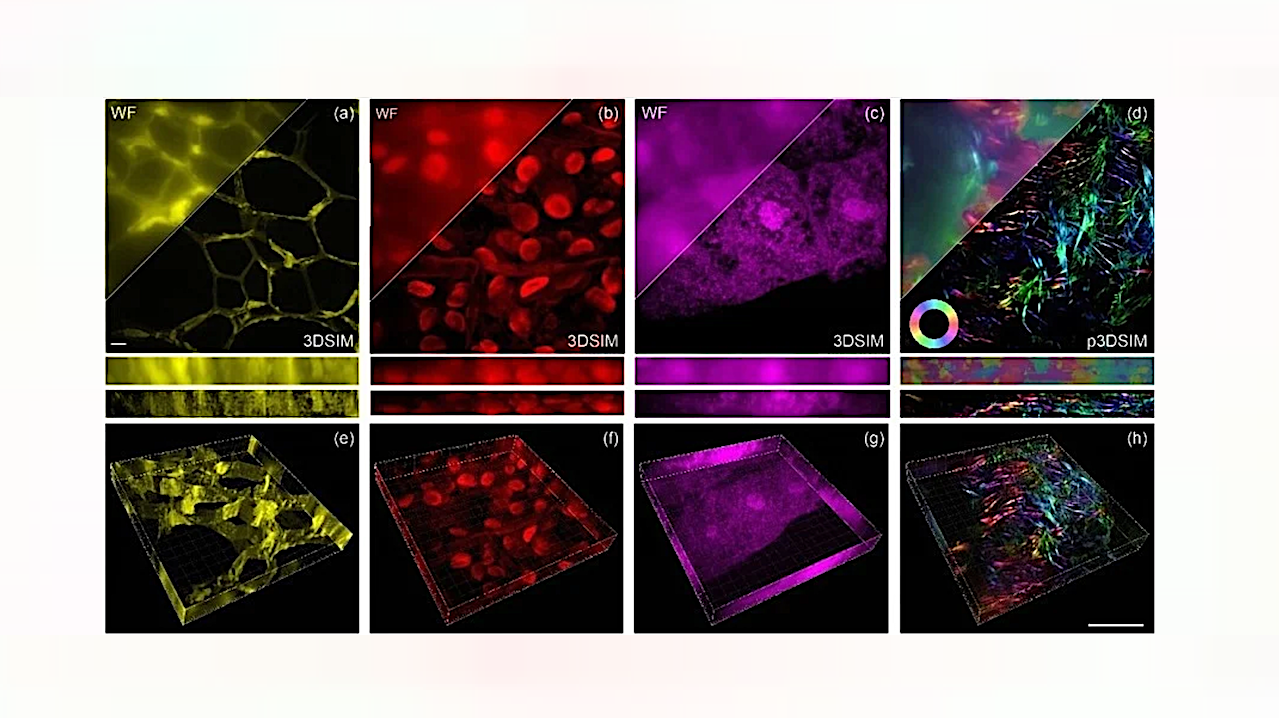
Open source Core technology embedded within the projector hardware enables high-speed, automatic polarization modulated 3D structured illumination microscopy (SIM) imaging. 3DSIM reconstruction of plant and animal tissue models: (a) cell walls in oleander leaves, (b) hollow structures within black moss leaves, (c) root tips of corn tassels, and (d) actin filaments in mouse kidney tissue; Corresponding maximum intensity projection (MIP) images are shown in the bottom row (eh), respectively. Scale bar: 2 μm. Credit Li, Gao et al., doi 10.1117/1.APN.3.1.016001.
Editor's note: When we send away teams to other worlds on astrobiology and astrogeology expeditions, they must be self-sufficient. In fact much of their preliminary research can be done off-world. Having the best, most compact tools is crucial. This applies to tricorders used on field trips and equipment reused at base camp. The technology described here—open source technology—is a promising example of what we can equip future explorers with.
The ever-growing field of microscopy has seen significant advances in both hardware and methodology in recent years, fueling the ability to explore the infinite wonders of life. However, the journey towards three-dimensional structured illumination microscopy (3DSIM) has been hampered by challenges arising from the speed and complexity of polarization modulation.
Introducing the DMD-3DSIM system
Enter the high-speed modulation 3DSIM system „DMD-3DSIM”, combining digital display with super-resolution imaging, allowing scientists to view cellular structures in unprecedented detail. As reported in Advanced Photonics Nexus, Professor Peng Ji's team at Peking University developed this innovative system around a digital micromirror device (TMD) and an electro-optic modulator (EOM). It overcomes resolution challenges by significantly improving both lateral (side-to-side) and axial (top-to-bottom) resolution, for twice the 3D spatial resolution achieved by traditional wide-field imaging techniques.
Polarized insights into cellular structures
In practical terms, DMD-3DSIM can capture intricate details of subnuclear structures such as the nuclear pore complex, microtubules, actin filaments, and mitochondria in animal cells. The application of this system has been extended to study highly dispersive plant cell ultrastructures, such as cell walls in oleander leaves and hollow structures in black algal leaves. Even in a mouse kidney slice, this system revealed a pronounced polarizing effect on actin filaments.
An open gateway to discovery
What makes DMD-3DSIM even more exciting is its commitment to open science. Xi's team has made all hardware components and control mechanisms openly available on Github, fostering collaboration and encouraging the scientific community to develop this technology.
The DMD-3DSIM technique not only facilitates significant biological discoveries but also lays the foundation for the next generation of 3DSIM. In applications involving live cell imaging, bright and highly photostable dyes, denoising algorithms, and deep learning models based on neural networks promise to improve imaging duration, information retrieval, and real-time reconstruction of 3DSIM images from noisy data. By combining hardware and software openness, the researchers hope to pave the way for the future of multidimensional imaging.
For more details, Y. Li, R. Read the original COLD Open Access article by Gao et al., “High-speed autocoherence modulation three-dimensional structured illumination microscopy,” Adv. Photon. Nexus 3(1) 016001 (2023), doi 10.1117/1.APN.3.1.016001.
Astronomy, Trinity,

„Oddany rozwiązywacz problemów. Przyjazny hipsterom praktykant bekonu. Miłośnik kawy. Nieuleczalny introwertyk. Student.
